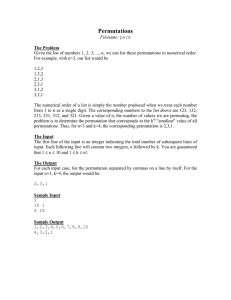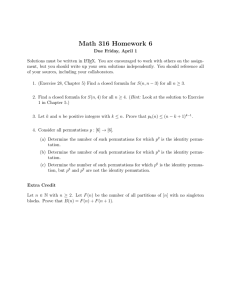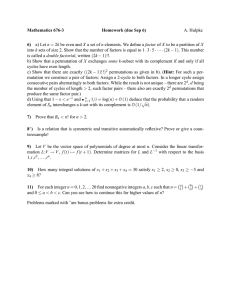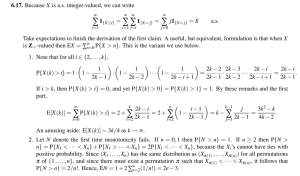Handout - UCLA Department of Mathematics
advertisement
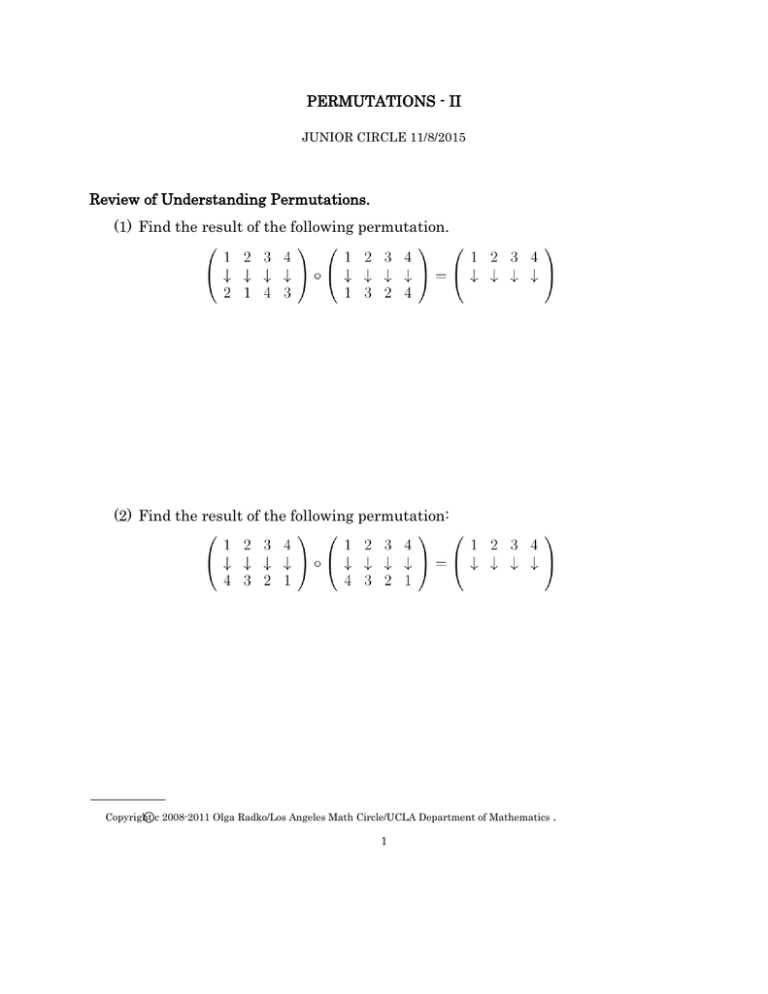
PERMUTATIONS - II JUNIOR CIRCLE 11/8/2015 Review of Understanding Permutations. (1) Find the result of the following permutation. (2) Find the result of the following permutation: Copyright ⃝c 2008-2011 Olga Radko/Los Angeles Math Circle/UCLA Department of Mathematics 1 . LAMC handout 2 Switching Positions vs. Switching Cards. (1) Play the following game with your partner several times: • Take 5 cards with numbers 1,2,3,4,5 written on them; • Mix the order of the cards and put them on the table in the new order; • Ask your partner to return the cards to the original order (1,2,3,4,5) by repeating the following operation: (a) switch card in position 1 with a card in another position; Do you think you can always return to the original order this way? (b) switch card with number 1 written on it with any other card; Do you think you can always return to the original order this way? Compare the games in parts (a) and (b). (2) Let’s look at how the order of the cards on the table corresponds to a permutation. (a) Suppose that we have the following permutation: Write down the order of the cards on the table that corresponds to this permutation: Draw the braid that corresponds to this permutation below: LAMC handout 3 (b) Suppose the cards are put on the table in the following order: 2 3 1 4 Write down the permutation that corresponds to how this order was obtained when the cards were originally in chronological order: Draw the braid that corresponds to this permutation below: (3) Suppose the cards are in the order (3,2,4,1). How can we get back to the original position (1,2,3,4) by performing several switches with position 1 (i.e., with the card that is on the left)? Model this with the following: • First, switch cards in positions 1 and ; • Second, switch cards in positions 1 and • Third, switch cards in positions 1 and • Forth, switch cards in positions 1 and ; ; ; Note: You may not need to use all 4 of these steps, you can use less and still put the numbers into the original order. LAMC handout 4 (4) Suppose the cards are in the order (3,2,1,5,4). How can we get back to the original position (1,2,3,4,5) by performing several switches with position 1? • Model this with the following: – First, switch cards in positions 1 and ; – Second, switch cards in positions 1 and – Third, switch cards in positions 1 and ; – Forth, switch cards in positions 1 and ; – Fifth, switch cards in positions 1 and ; – Sixth, switch cards in positions 1 and ; Note: You may not need to use all 6 of these steps, you can you less and still put it into the original position. Composition of permutations is NOT Commutative. (1) Find the result of the permutation by performing two transpositions in a row: • Model this with cards to figure out where the positions move after the two switches: ↓ ↓ ↓ LAMC handout 5 4 (2) Find the result of performing two permutations in a row: • Compare the results from 1 and 2. Are they the same? Why or why not? Does the order matter in which you perform these two permutations matter? LAMC handout 6 5 (3) Find the result of the two permutations below: (c) Compare the results. Are they the same? Why or why not? (d) Does the order in which you perform these two permutations matter? (e) What is the difference between this problem and the previous one? LAMC handout 7 More Problems. 1. How many different 5-symbol license plates are possible if the first symbol is a letter and the remaining four are digits 0-9? (Letters and digits can repeat). 2. There are two plates on the table. One plate has 10 different candies, the other has 8 different fruits. How many ways are there to choose one candy? How many ways are there to choose nine candies? How many ways are there to choose seven fruits?
